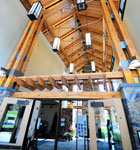1. Win the bid
In August of 2011, the US Bureau of Reclamation put out an RFP for a fish barrier—basically a shallow damn—on the Blue River to protect it from predatory species found in the adjoining San Francisco River. Walker and the SBBI team drew from their decades of experience working on government infrastructure contracts to put together a detailed bid at the best value, winning them the job.
2. Establish a game plan
SBBI’s bid also offered the best solutions to the project’s myriad challenges, one of which was the timing. The firm’s proposed schedule began the second week of October, affording enough time to finish before the high-flow periods on the river. However, since the job wasn’t due to be awarded until October 1, SBBI had to line up and schedule subcontractors on spec.
3. Mobilize equipment, supplies, and manpower
The minute the contract was awarded, things started moving. The first hurdle was getting to the site. Through Siller Helicopters, SBBI had lined up two decommissioned Sikorsky helicopters to fly in disassembled excavators, dozers, concrete plants, and 3 million pounds of cement. “The Bureau of Reclamation was amazed at how fast we were able to get the equipment into the wilderness,” Walker says.
4. Assemble camp and prepare the site
A wilderness it was. SBBI established a base camp eight miles from the site, in the pasture of an accommodating rancher. A third helicopter ferried the 24-person crews to the river every day. Extensive antierosion measures were taken at both the job site and the base camp to protect the surrounding environment. “It’s such a magnificent wilderness area,” Walker says. “We really wanted to put our best foot forward.”
 5. Ensure job-site safety
5. Ensure job-site safety
For every step of the job, SBBI’s safety officer, Sue Downing, established extensive safety measures. For example, before any work on the river could be done, HI-TECH Rockfall Construction Inc. came in with rock climbing teams that scaled the cliffs and removed any loose material that could fall on crews working below. The SBBI crews also paid close attention to US Geological Survey reports about variations in the river’s flow.
 6. Divert the river
6. Divert the river
When construction began, SBBI did it in two phases, building half the dam at a time. As the firm began each phase, it built a channel for the river, hemming it in with a large berm and lining it in plastic to prevent the intrusion of water into the subgrade.
7. Excavate and dewater the barrier’s foundation
The next step was to dig the trench for the barrier’s footing. Subcontractor Hardy Hole Drilling got through the riverbed’s upper strata, but the company had to stop drilling the well points it had planned on when it hit an unexpected geological formation. Instead, the SBBI crews proceeded with excavators until they had a 26-foot-deep, 52-foot-wide trench with massive sumps installed to keep it dewatered.
8. Pour the roller-compacted concrete footing
The footing of the barrier was not only sunk those 26 feet into the riverbed; it was also poured with roller-compacted concrete (RCC), a specialty mix that requires little hydration and develops a compressive strength of 4,000 psi. For each stage, SBBI poured the RCC foundation in batches, compacting it with a vibratory roller and capping it off about six feet above the riverbed.
9. Pour the heavily reinforced weir
The final piece of the barrier is the concrete weir—the smooth, concave surface over which the river flows. Connected to the foundation and bedrock and reinforced with 128,000 pounds of steel rebar, the weir was poured with a standard concrete mix, which delivers the tensile strength the barrier needs to hold up to the river’s constant flow, Walker says.
10. Reestablish the native flow of the river
Once both halves of the weir were complete, SBBI’s last steps were to divert the river one last time—to allow the firm’s crews to tidy up the riverbed and remove the pumps—and then restore the river to its original path. Then, it was just a matter of dismantling and flying everything out—and saying goodbye to the Blue River adventure. “I probably will never get to do another job like this in my lifetime,” Walker says. “I’m so glad I got to do this one.” ABQ





